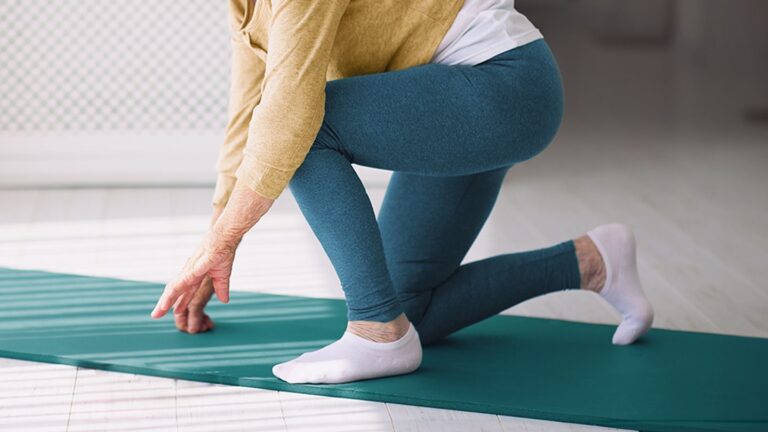No Hands and No Knees Means a Perfect Score
To perform the test, researchers asked each participant to sit on the floor with their legs crossed in front of them and then get back up, using as little support as possible.
The researchers assigned each action (sitting and rising) a value of 5 points total, with points subtracted for each support used:
- Minus 1 point for each hand, forearm, or knee used
- Minus 0.5 points for unsteadiness
They then added the two scores for a maximum of 10 points.
The test was created back in the late ’90s by the study’s lead author, Claudio Gil Araújo MD, PhD, physician and dean of research and education at the Clínica de Medicina do Exercício (CLINIMEX) in Rio de Janeiro, Brazil.
“I realized that not only is aerobic fitness important for health, but also what I call nonaerobic fitness,” says Dr. Araújo.
The beauty of the test is also how simple and accessible it is, he says. “It’s also safe, valid, reliable, and easy to score — and it’s simple to understand what the results mean,” Araújo says.
People Who Struggled With the Test Had a Much Higher Risk of Early Death
The study included more than 4,000 adults, aged 46 to 75, who visited a health clinic in Rio between 1998 and 2023. About two-thirds were men, and all were able to complete the test without physical limitations.
Over an average follow-up of about 12 years, nearly 700 participants died (about 15.5 percent). The researchers excluded anyone who died from COVID-19 or external causes like accidents in order to focus on deaths from natural and cardiovascular causes.
The investigators found that the likelihood of death increased significantly as sitting-to-rising scores declined:
- Score of 10: 3.7 percent death rate
- Score of 8: 11.1 percent death rate
- Score of 4 or less: 42.1 percent death rate
Even after adjusting for age, sex, body mass index, and existing health conditions, those who scored in the lowest group (0–4) were 6 times more likely to die of heart disease and 4 times more likely to die of any natural causes compared with people who scored a perfect 10.
The Test Assesses Balance, Flexibility, Muscle Strength, and Coordination
Unlike traditional fitness assessments that focus on aerobic capacity (like running or cycling), the sitting-to-rising test evaluates nonaerobic physical fitness.
“It requires different domains of physical capacity: muscle strength, balance, flexibility, and coordination,” says Amy Pastva, PhD, PT, director of research in the physical therapy division and a senior fellow at the Duke University Center for the Study of Aging and Human Development in Durham, North Carolina.
Dr. Pastva, who wasn’t involved in the study, says each of those different components has an association with healthiness or unhealthiness, which would translate into how likely a person is to develop chronic disease, she says.
“This study is valuable because it focuses on components of function that many might not otherwise think about, and yet, it is precisely this type of coordination/activity that is important for all of us to maintain our best potential to live independent lives as we age,” says Deborah Kado, MD, a geriatrician at Stanford Health and co-director of the Stanford Longevity Center, both in Palo Alto, California. Dr. Kado was not involved in the research.
Poor balance and flexibility increase the risk of falling, which can lead to serious injury or death in older adults. Weak leg strength and poor muscle tone can make it harder to perform everyday tasks like standing up from a chair, climbing stairs, or carrying groceries, according to the study authors.
Take the Test at Home
Want to try this challenge yourself? From a standing position on a flat, nonslip surface, cross your legs and try sitting down on the floor, then standing back up without using your hands or knees or wobbling. Have a companion “spotter” nearby to prevent you from losing your balance and falling.
If you’re unclear on how to do the test, check out the YouTube video the research team posted.
Subtract 1 point for each support and 0.5 for any loss of balance. Add your sitting and rising scores for a total out of 10.
A low score doesn’t mean you’re doomed; it just means you need to work on some areas with the right types of exercise.
The authors identify four key areas that can help improve your score:
Araújo points out that many people tend to focus only on the activities they’re already good at — runners run, lifters lift weights, and so on. “But improving your weaker areas can have a powerful impact on your overall health and even your life expectancy,” he says.
Use Your Results to Create a Plan
Rather than focusing on the increased risk of early death, Pastva suggests that you use the test as a conversation starter with your primary healthcare provider.
Kado agrees, adding, “If you didn’t do well, figure out the major limiting factor or factors.”
Is it hard because you don’t have strength in your legs? Or is it flexibility — are your legs too stiff to bend in a cross-legged position? “Or do you have the strength, but feel like you don’t have the balance? Or is it a matter of coordinating this set of movements?” she says.
Once you identify the most challenging part of the test, try to develop strategies to improve that component, says Kado.
Your results may also indicate you need to do some planning in case you do find yourself on the ground, perhaps due to a fall, says Pastva.
“If you couldn’t get up off the floor without assistance, or you needed to crawl over to a couch or chair, it’s important to think about what you would do. How can you ensure you’ll be able to get the help you need?” she says.
Read the full article here


